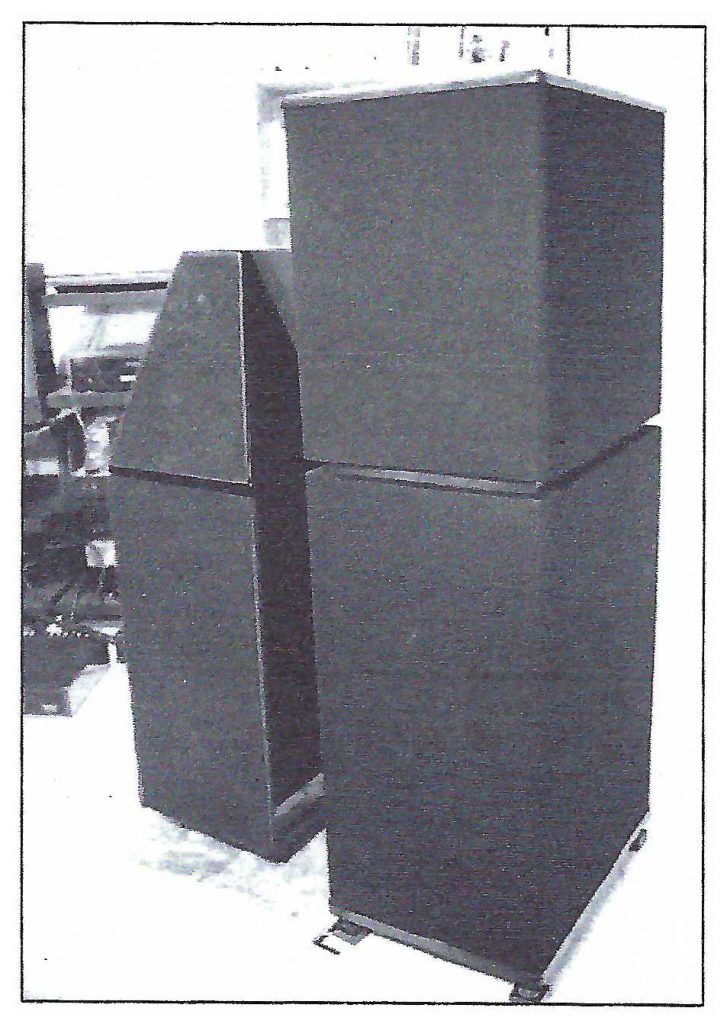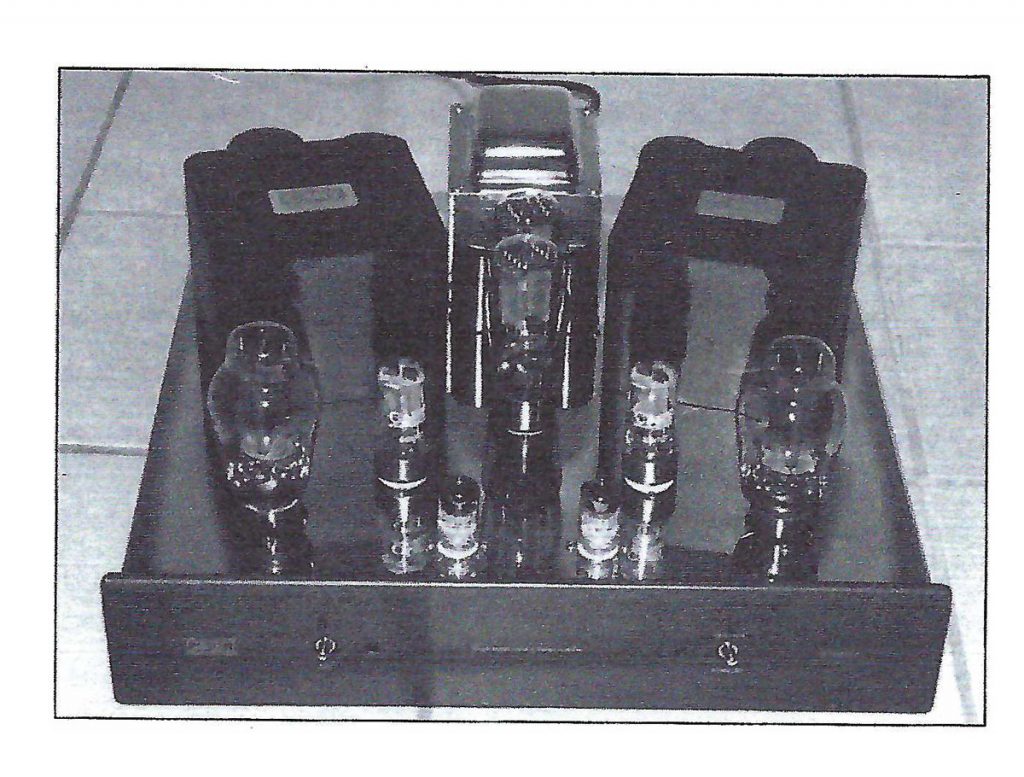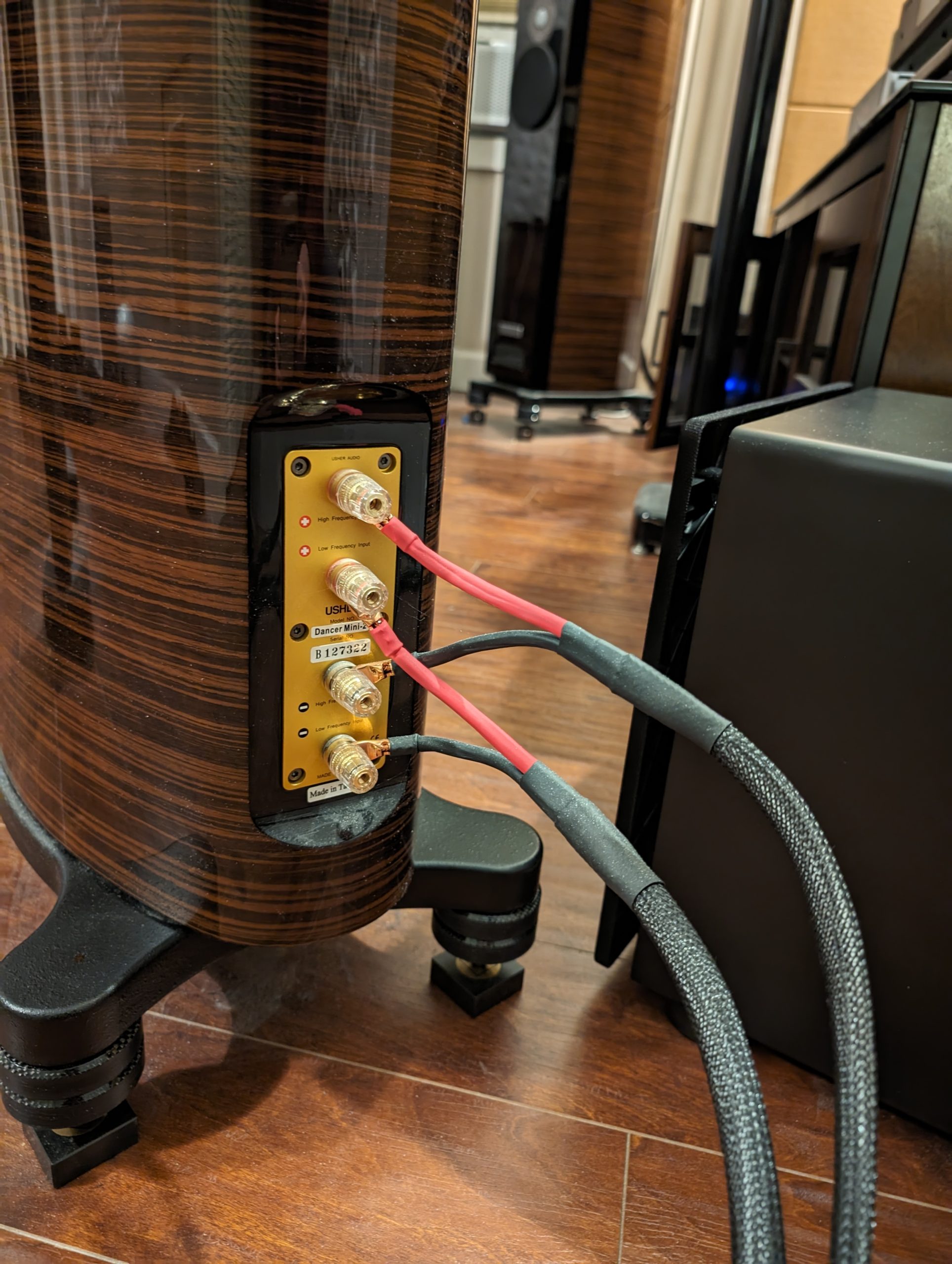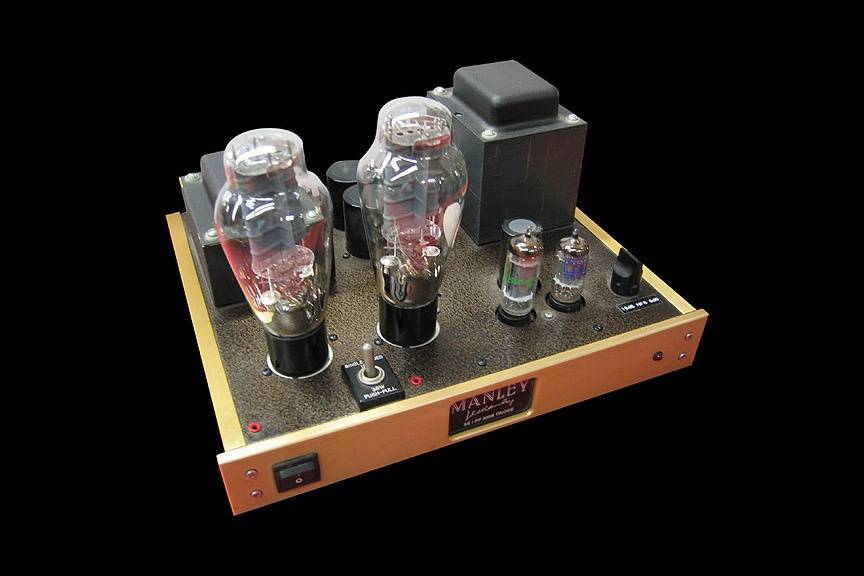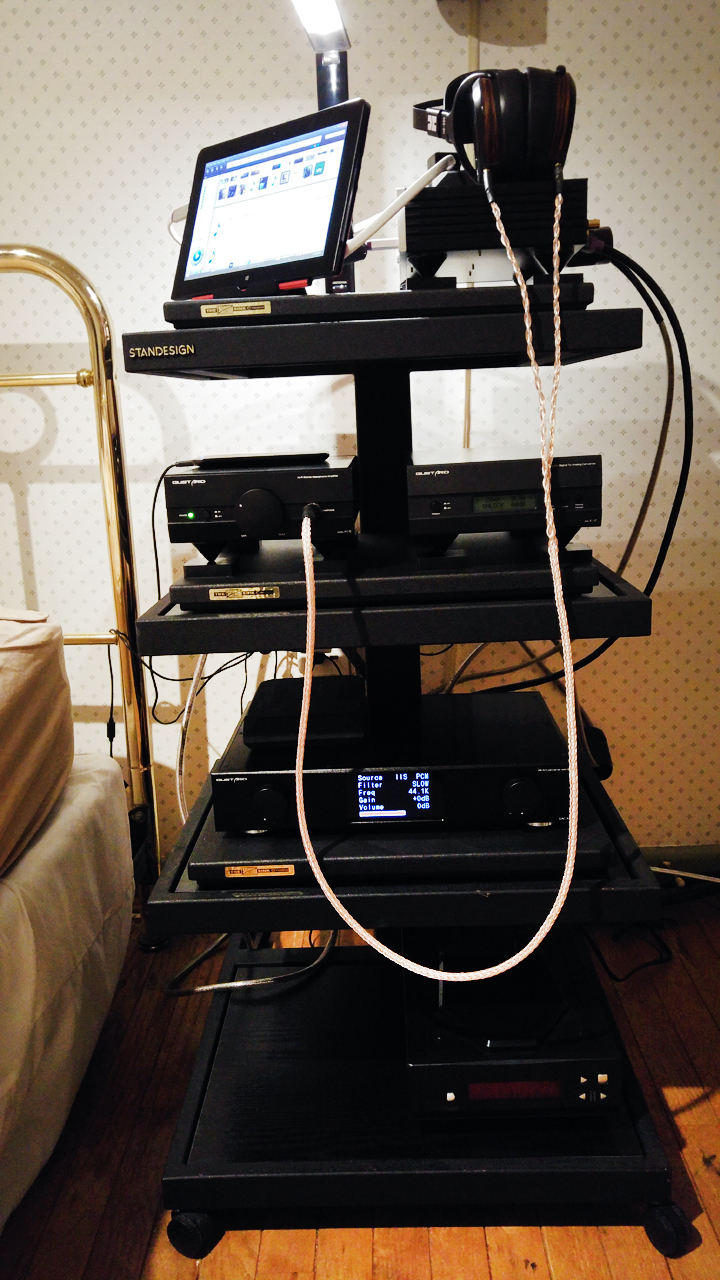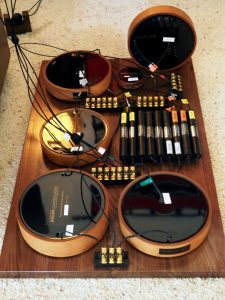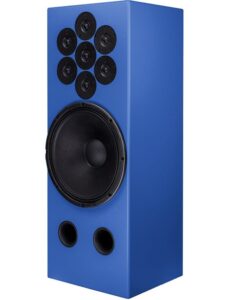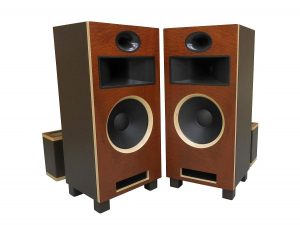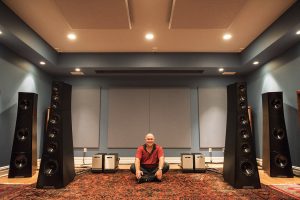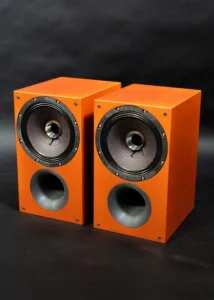From Positive Feedback magazine in print, Vol. 5, No. 6, Summer, 1995
The prospect of doing the first review of a new loudspeaker from the hands of Albert Von Schweikert filled me at the same time with excitement and with anxiety. The excitement was understandable. I had owned and cherished a pair of his Vortex Kevlar Reference Screens for the past five years. My listening room and system had seen a world of change during that time, but there was always the KRS's at the center, the stationary leg of the compass around which all of my system changes revolved. I had flirted with speaker changes during these years, but I always found other elements to be the weak link in my system and no other loudspeaker had made me want to retire the KRS, my trusted friends. But then I hear from their creator that he had a new speaker that surpassed the performance of the KRS's in every parameter—Whoa! That was something to get excited about!
So where did the anxiety come from? Well...I suppose it came from a thought that lingered in my mind from the first day I talked to Albert about the VR-4. I've known Albert for about six years now, and although we haven't been burning up the phone lines, we have stayed in touch. During the days of his company Vortex Acoustics, I had provided Albert with business legal advice and had even toyed with the idea of helping him distribute his Vortex products in Canada. Although nothing more came from our ideas at the time, we still remained friends, and I'd occasionally call Albert to see how he was doing and tell him about my latest tweaks on the KRS. Because Albert is my friend, it is particularly difficult when it comes time to review a speaker that I know has been a labor of love for him, and one which he considers to be his very best work. The anxious thought was, "what if they're not better than my modified KRS... how would I break this news to Albert?"
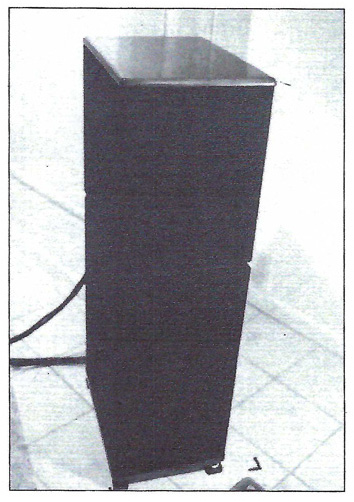
The Von Schweikert Research VR-4 Loudspeaker
The problem lay in the potential for disappointing or discouraging a friend. The review itself was not the problem. In keeping with PF's editorial policy, if I personally didn't care for the VR-4, I could decline the review, or let another staff writer take a shot at them. The fact that Albert is my friend and that I provided business advice to him in the past and may do more in the future, was not the problem either. As our editor has stated numerous times in these pages, we here at PF are into community and collegiality—we expect to develop friendships with others who share our joy of music, and that includes those who manufacture the systems that deliver it. If relationships are openly acknowledged, building the "Chinese Wall" between reviewer and manufacturer is not only not necessary, it is, in our opinion, counterproductive. Getting to know the manufacturer well, getting inside his head, if you will, can yield some insights on the design and its sonic attributes that might otherwise have escaped the more cursory analysis. Moreover, I think that there are a lot of readers, who, like me, enjoy knowing something about the heart and soul of the people behind the products. A "community" of high-end audio focuses on the people in it, and how they relate to one another. If we ever elevate equipment or music above people, PF will have lost its unique spirit and will be just another audio rag.
I'm sure my concerns about my friendship with the manufacturer are a somewhat common, but usually unspoken occurrence for mainstream reviewers. Since it is the first such occurrence for me, I thought I should make a clean breast of it. Those who know me well will not have the slightest concern about this—they know that I always tell it like it is and that I never buy a review sample for my reference system unless it satisfies my listening preferences, has overall outstanding performance and represents a true highend value—I've got some of that Scottish blood, don't ya know (am I tipping my hand here, or what?) For those of you who don't know me, and may wish to avoid some of the audio angst that this review will no doubt produce, you have hereby been provided with a very large grain of salt with which to take it.
I'll come down off of my soap box now.
Albert Einstein, Albert Schweitzer....Albert Von Schweikert!
I remember well my first conversations with Albert. I had grown somewhat tired of a pair of Vandersteen 2ci, and was looking for an affordable loudspeaker that would be a little less woolly in the bottom end and give me a bit more midrange transparency and top end extension. Reading through back issues of Stereophile, I spied a very favorable review of the Vortex Screen loudspeakers, written by Robert Harley. His description of the sound of these speakers seemed to fit perfectly with my current desires, the price was right, and I must say I was more than a little intrigued to learn more about a guy with a name like Albert Von Schweikert. I gave Bob Harley a call to see if this Von Schweikert guy was for real, and whether the speakers were still in production. Bob assured me that Albert was very much for real and briefly described to me a fellow who was a somewhat unusual, gentle spirited scientist. Well....now I was hooked—the name association and Harley's comments made me think Albert Von Schweikert must be a genius like Albert Einstein and a great humanitarian like Albert Schweitzer all rolled into one.
After two telephone conversations that lasted a total of about six hours, the Einstein / Schweitzer thing didn't seem all that far-fetched—Albert could talk a blue streak on speaker design—"zooom," right over my head, like Mr. Einstein giving my brain a cosmic enema on the theory of relativity—and like an audio Schweitzer, he really seemed to care more about the joy of music and the needs of us 'philes on a budget, than he did about personal fame or fortune. I bought a pair of the Vortex KRS's sight unseen and sound unheard and I wasn't disappointed.
The overnight sensation that was over twenty years in the making.
The Company name Von Schweikert Research is new, as is the VR-4 loudspeaker, but Albert certainly is not a new face in high-end audio, nor is the speaker a flash of inspiration with no history. Both designer and speaker have an interesting pedigree that I think you should know about.
Albert Von Schweikert has been an audio hobbyist since 1957 when he and his father built a 10-watt Eico kit integrated amplifier and a 15" Jensen coaxial speaker kit. Since the 15" speaker did not sound as clear on piano recordings as a set of crystal headphones, Albert, then 12, began to experiment with the speaker to try to improve the sound quality. Thus, a career was born.
In Heidelberg, Germany, Albert took piano and violin lessons at the Conservatory at Heidelberg University over a period of five years, and later switched his musical interests to the electric guitar. In 1964 he built a PA system of radical design in St. Petersburg, Florida which was used by bands playing at the Civic Center. Famous musical groups such as Sonny and Cher, Neil Diamond, and the Yardbirds played at this hall and remarked on the excellent sound quality of the speakers.
Seeking to improve on his technical knowledge, Albert spent seven years at two universities including the California Institute of Technology where he worked under Dr. Richard C. Heyser in the physics laboratory. Dr. Heyser was inventing a measurement system which he named Time Delay Spectrometry; this system could perform anechoic measurements in a normal room since gating was used. Time delays occurring in the drive units themselves could be studied as well as phase aberrations that plagued textbook crossover designs. An audio design club was formed by five students at Cal Tech, and Albert was chosen to be the official evaluator of the resulting designs since he was the only classically trained musician in the group.
Two years were spent in the laboratory as Albert and his group evaluated and measured all of the pertinent speaker designs of the period (1970s) including electrostatics, ribbons, and dynamic units. A plasma speaker Albert termed The Forcefield was built, which used high voltage to break air down into ozone that was then modulated by the signal to produce sound. A six-foot-tall ribbon speaker was also constructed for testing purposes, along with a transmission line subwoofer with a line length of twelve feet. This unit was reported to have response to 10 Hz. In this period Albert designed the first Vortex Screen, a time-aligned and phase-coherent three-way dynamic speaker using 24dB per octave filters, a first for an American company. The drivers and cabinet design were also years ahead of their time.
This research led to a job with Dr. Oscar Heil, inventor of the Heil Air Motion Transformer, at ESS Laboratories in 1982. Albert designed the first linear phase crossovers for the AMT and the first three-way Air Motion Transformer system. He also worked with Dr. Heil on the Transar, a push-pull series of rods and discs which emitted sound from a dipolar baffle.
After ESS was sold to new owners, Albert formed the Vortex Acoustics company which sold the Vortex Screen system factory-direct to consumers. Robert Harley, as technical editor at Stereophile magazine, reviewed the Screens in July, 1989, Vol. 12, No. 7. In his review, he called the three-way cone system legendary, since it had been an underground product with high acceptance with both musicians such as Mark Andes of Heart, and recording studios such as Mobile Fidelity. The Screens were said to have spectacular imaging, tremendous bass response, and a sense of realism lacking in competing products. Harley also noted that the Screens were better sounding than Theil, Snell, or Vandersteen speakers and were "highly recommended."
At the same time, Albert had a position with KSC Industries, the second largest driver manufacturer in the world, as a driver designer and Quality Assurance engineer. From 1987 to 1989 he worked on more than 100 projects for companies such as Apogee, Bose, Cerwin Vega, JBL, Jensen, NHT, Paramount Pictures, and many others.
In 1990 the Vortex Kevlar Reference System was shown at the summer CES (Consumer Electronics Show) with VTL sharing the suite and providing their excellent tube equipment. Corey Greenberg of Stereophile magazine was "really knocked out" by the KRS, calling them "highly musical with pinpoint imaging and depth out the..." Vol 14 No. 8, August 1991.
Next, in 1993 at the Winter CES, Albert showed his awesome $59,000 Concert Master Armageddon system. This four-tower system used 20 Kevlar drivers, including 18" subwoofers with response down to 10Hz, and weighed over 2000 lbs. Guy Lemcoe of Stereophile named the Armageddon the "Most Spectacular Sound Of The Show" in Vol. 16, No. 4, April 1993.
In 1991 Albert became a consultant to Counterpoint Electronics and designed the Clearfield Continental and Metropolitan systems along with a Home Theater speaker system. Martin DeWuIf of Bound For Sound awarded the Continental a place on his Recommended Components in the December 1993 issue. Haute Fidelite of France named the Metropolitan "one of the best systems in the world." Larry Johnson of Audio Video Interiors called the Metropolitan "one of the handful of best speakers in the world" in the December 1992 issue.
Most recently, Video magazine in the January 1995 issue awarded the Counterpoint Home Theater System designed by Albert "The Best Home Theater Speakers Over $2500." This system uses THX technology for the subwoofers and rear surrounds, but Albert's own technology for the front three speakers. Brent Butterworth, the author of the piece, concluded by saying, "they may be our favorite speakers of all time."
Apparently impressed by the quality of Albert's Home Theater System, Lucasfilm's equipment design division, THX, hired Albert for theater sound system evaluation in 1994, and have recommended him as a qualified THX designer to other manufacturers.
Phew!..how'd you like to include all that in your resume!?
I've gone to the effort of detailing this, including some comments by other reviewers on Albert's designs, so that you will appreciate what it means when Albert says that the VR-4s, at a promotional price of $3000, are his best work to date. Also, quite frankly, I don't want you to think I'm completely nuts when you read the rest of this review and see the comparisons I'm going to make.
Technical Details
OK... techno dweebs, here goes.... The Von Schweikert Research VR-4s stand 46" high, 13.5" wide and 19.5" deep. They weigh in at about 120lbs for each side. They are tower speakers that have a separate bass module with two eight inch woofers with separate crossovers. One woofer runs from the basement up to 125Hz where it is crossed over to the midrange driver, the other woofer is rolled out when it reaches 40Hz. The separate woofer crossovers provide killer bass down to 20Hz (my in room measurement was actually flat at 20Hz when four feet from the back wall and -1dB when moved out to seven feet), by having both drivers working together at the lower frequencies without the mid bass bump that I've heard from other two woofer systems that allow both drivers to run all the way up to the midrange crossover point. Each of the woofers is a polypropylene / epoxy resin hybrid with a separate enclosure and rear firing port within the bass module.
The separate Midrange / Tweeter module sits, or I should say docks, on top of the bass module to form an elegant tower. The midrange and tweeter have separate time aligned cabinets inside the dowel supported, cloth covered module, reminiscent of the Vandersteen design. No one would ever mistake them for Vandies though, given their dimensions and two-piece configuration. The crossover circuit for the woofers is inside the woofer module, while the crossover for the midrange and tweeter is located externally on top of the midrange enclosure. This midrange enclosure looks like a long rectangular box that extends the full depth of the speaker. Internally, however, the sides are not parallel. There are baffles inside that channel the rear wave reflection away from the driver and through a labyrinth of increasingly dense absorptive material until the back wave is 100% (theoretically) absorbed by the time it reaches the rear end of the enclosure.
The front tweeter is mounted on what looks like a three inch thick solid piece of wood which is curved to match perfectly the top curve of the metal tweeter baffle. There is one inch thick felt on all of the surfaces, including the underside of the wood top cap. The top cap looks to be a good eight inches above the top of the tweeter, so there shouldn't be much reflection off of it (...something that always troubled me with the Vandersteen design). Any sound waves that do head in the top caps direction should be absorbed by thick felt underlining.
The midrange driver is a 5.25" woven carbon fiber model made by Audax, and is reported as having a range of 57Hz to 12kHz. The hand off to this driver begins at 125Hz and ends at 3.5kHz when it is crossed over to a Vifa aluminum dome tweeter. These crossover points are significant, because you won't hear much in the way of human voice above, or below this range. The low crossover is also very nice for bi-amping when mixing solid state and tubes (particularly single-ended tubes). I've tried it on other speakers with higher crossover points, including my KRS that cross at 250Hz, without much success. The very different character of the tube and solid-state sound is much too obvious when the hand-off occurs in the lower midrange. At the VR-4's 125Hz crossover, there doesn't seem to be as much of the same weird juxtaposition of sound characters. With level adjusted by a series resistor, my Meitner monoblocks sounded very good on the bottom with the Anodyne MP300 monos on top.
There is a small rear firing tweeter mounted inside the sock at the rear of the mid/tweet module. This tweeter has its own crossover to integrate properly with the front firing tweeter. A rhodium plated toggle switch is located on the binding post cup that allows you to turn off the rear tweeter in case you have to place the speaker too close to a rear wall, or your room is too bright. A second toggle switch on the other side of the binding posts allows you to cut the top end response of the tweeter by one dB. Albert tells me that later models will have a three-way switch allowing no cut, 1dB, and 2dB attenuation. I think this kind of flexibility is a good idea because of the tremendous variation in high frequency response you find in different rooms and systems. In my room, I got the flattest response and best soundstaging with the rear tweeter on and no attenuation.
Both the woofer and mid/tweet modules have separate Cardas gold / rhodium binding posts that easily handle the thickest of cables. From the location of these separate binding posts (about three feet apart), it is obvious that Albert intended these to be bi-wired, rather than jumpered. I bi-wired them with two eight-foot sets of the Tice 416 cables (by the way, the VR-4s love these cables as much as my KRS did).
The woofer and midrange enclosures are extremely dead. The knuckle rap test only tells part of the story. When you listen to music, you can't detect any cabinet colorations or resonance. Albert has accomplished this by a really clever constrained layer damping technique that I'm not at liberty to disclose—made me make one of those attorney/client oaths of confidentiality...sheesh! (see Albert's designer notes for more on this). The effectiveness of this damping technique has got to be heard, or I should say "felt," to be believed. We got a little crazy with the volume playing some "boom car" music and got everything in the room vibrating—at least so I thought, until I put my hands on one of the bass module cabinets and felt almost no vibration.
The crossover networks are incredibly complex. There is a total of five drivers in this speaker, and each one has its own customized compensating circuit. Albert considers the circuitry that melds the drivers together to be the most important part of the design. The "Virtual Reality" presented by the VR-4s in four dimensions (time being the fourth) has been accomplished by a circuit optimizing time, phase, amplitude and impedance (hmmm...another four) which Albert calls the Global Axis Integration Circuit (tm) ("GAI circuit"). The GAI circuit design offers 24dB acoustic slope performance for flat off-axis frequency and phase response at more than 90 degrees horizontally and 70 degrees vertically off axis, using only quasi first order electrical filters with integral phase and impedance compensation. The impedance compensation is performed by Zobel auto-tracking circuits which compensate for rising impedance that moving coil drivers exhibit due to inductance of the voice coil. The result is a nominal impedance of 6 ohms, with deviations limited to +3 and -2 from 20Hz to 25kHz, excepting a slightly larger dip at about 22Hz.
In order to integrate the phase compensator, the EQ network, the amplitude level matching and the crossover filters themselves, Albert used a program called "SPICE". This circuit optimizer "looks" at the combination of the different circuits and integrates them into simpler combinations which results in one part having several functions. (Not exactly, but close enough for a "simple" explanation.) This program enabled Albert to reduce the parts count of 36 components down to 14 by combining the circuits, and thus reduced the overall phase rotation. Since there are very few parts directly in the signal path, (most are ground shunt circuits), the overall transparency is kept very high. In fact, there are no more parts in series than many first order circuits.
Measured sensitivity of the VR-4 with a 2.83 v input at a distance of one meter is 87dB—about average for a dynamic driver speaker. Despite the average sensitivity, they worked well with many of the low power tube amps I had on hand. I found that the realistic low power limit to be about 17 watts. The Audio note P2SE signature and Anodyne MP300 are both rated at 17 watts and produced adequate loudness levels in my 14' x 29' room (until my frequent listening companion, Dr. Chuck, comes over and wants to play Rite of Spring at concert levels). The friendly impedance of these speakers—no major peaks or dips—no doubt benefited the single-ended amps. As discussed later in this article, I think a little more power is needed to get the best of the very low bass these speakers are capable of.
Oh yeah, I should mention that although these speakers are covered with a thin black cloth, they nevertheless have a very rich, elegant appearance due mainly to the gorgeous hand rubbed hardwood end caps and center docking strips. The edges of the end caps are radiused, so you know that they're not veneered. The VR-4's proportions, fit, and finish should yield a reasonably high designer acceptance factor. Our household's designer gave them a big thumbs up. The operative word here is "big"—"yah Hans...this is no 'girly man' speaker...just lift the bass module now—yah, that's goooood... VR-4s will Pump You Up!"
Still, it makes me scratch my head, just like I did when studying the quality of the Golden Tube SE-40—how's Albert making any money on this thing? Well, I think the answer is that he's not, at least not much right now. The speakers were priced such that a reasonable profit would be obtained when demand increases and the economies of bulk part purchases come into play. A risky, but I must say, refreshing way of doing business.
So, how am I doing so far?... thorough... well reasoned... but perhaps I'm being a tad restrained. Well, alrighty then, I'll let you read how this frugal Scotsman first described the VR-4's to my friends on The Audiophile Network:
It's very early on Monday morning and I'm dead tired, so I probably shouldn't be doing this...and I'll probably be accused of being an audio tease again (and rightfully so), but tough noogies!...Before I hit the sack I just want to relieve a little tension....
ALBERT DID IT!...the VR-4 is the Golden Tube of loudspeakers...these babies don't just blow air up my kilt, they fire hose it right up over my head, pull my shorts down around my ankles and tie a knot in them!
(I'm thinking here of the experience of being "pantsed"—the embarrassment of being suddenly bare assed in public. That's the feeling I get with these speakers—I'm vicariously feeling the collective embarrassment of the manufacturers of all those over-priced loudspeakers ...well, O.K., so it's a little exciting too.)
They're just stupid good at a price that's a joke. Just how good?...well I just got done tonight setting up my friend Chuck's system which is all Audio Research (including the VT150s), transparent Audio cables and the new Wilson Watt/Puppy 5s and I think Chuck's in for the shock of his life when he compares price tags and listens to the VR-4s. That will be happening this week at my place —the VR-4s vs. the Watt/Puppy 5s and it's not going to be pretty!
...AND...they sound fantastic being driven by a single Golden Tube SE-40!
Did you hear that...way out there across the moors, it's the plaintive reedy wail of the bagpipes...and they're playing a tune on an amp/speaker combo that costs under $4000 retail!...Hmmmm...what's Chuck got into his?... oh... about $26,700!
...AAHAHAHAHAHAHA!
I feel much better now and it's definitely time to hit the sack.
Stu obviously gets a little punchy when he's tired; but seriously, I consider the VR-4s at $3000 to be a giveaway when you consider the price of other high end speakers. I can't think of any speaker under $10K that is flat to 20Hz, has as sophisticated a crossover and cabinets as well built as these—and I haven't even begun to tell you what they sound like.
As for the Wilson Watt/Puppy 5—they're good, real good. I'm not making the comparison to take shots at the Wilsons. They're a benchmark loudspeaker whose size and sound many people are familiar with—which makes for an unusually effective and meaningful comparison. They also just happened to be available.
When Albert sent out the VR-4s, he mentioned to me his desire to have me compare the speaker to other highly regarded and more expensive products, including the Wilsons. I told him that I no longer had the Merlin VSMs or Mach 1 Acoustic DM-10s on hand, and seriously doubted whether I could get a review pair of the Wilsons on short notice. Then, three days after the VR-4s arrived, Dr. Chuck hits me with the revelation that he's bought a new system that includes the Watt/Puppy 5s!...well now, you can't expect me to overlook such a providential occurrence, can you?...
...and there was much rejoicing as they gathered up the speaker manna and brought it into the dwelling known as Stu's Place.The Wilson Watt/Puppy Vs and VR-4s from port and starboard.
The Wilson Watt/Puppy Vs and VR-4’s from port and starboard
For the listening evaluation my system consisted of the PS Audio Lambda and Theta Data Basic transports; Mach 1 Acoustics semi-rigid digital cables; Audio Alchemy DTI-Pro; Audient Technologies A.U.D.I.T.; Polyfusion Audio, Mach 1 Acoustics, Theta Pro Basic III digital converters; Reference Line Preeminence and Melos SHA-1 Gold preamps; Tice Audio IC-1 interconnects and bi-wired runs of Tice 416 cable; Meitner MTR-101 mono blocks and more tube amps than you can shake a stick at, including the Golden Tube Audio SE-40, Anodyne MP-300, Cary 300 and 301 SE, Audio Note P2SE, Manley mono blocks...oh, you know...all the "Tube Fest" participants. Various isolation devices were used with the equipment, including Bright Star Big feet and little rocks and under the speaker spikes I used A.R.T. Audio Q-dampers.
The Cary 301SE...hey! How'd this get in here?! (Any wonder why the TANpals call me an audio tease?)
Placement of the speakers for good imaging and tonal balance was not hyper-critical, provided you maintain a free field placement. The dispersion pattern of the VR-4 is so broad, that you'd have to work at it to not get good performance. I settled on a position seven feet out from the rear wall and about three feet from each side wall with a 12 degree toe in. That placed the center of the speakers 7.5 feet apart and my listening position eight feet on the diagonal from each speaker. Toe-in was a matter of taste for the amount of upper midrange energy and density of center images I preferred. The changes due to toe-in were really pretty subtle and seemed to have no effect on the width of the soundstage.
Let's get the bass out of the way first. Using warble test tones, I measured flat to 20 Hz at my listening position. This was with the Meitner monoblocks and the speakers about four feet out from the rear wall. When I pulled them out to the final position, which was about seven feet out, the reading was -1dB at 20Hz. The bass is surprisingly articulate and tight all the way down there. Of course, the amp you use will have a lot to do with the control and extension. Most of the single-ended amps I had couldn't cut it much below 30Hz. There is an impedance dip at around 22Hz which makes the real subterranean stuff a little harder to drive.
The Golden Tube SE-40 did pretty well as a bottom feeder, getting down to the mid 20s with no problem. The Manley amps also shined as bass drivers, providing more gut thumping low end then a tube amp has a right to—but the most incredible bass was reserved for the solid state Meitner monoblocks, which exhibited incredible depth and control when run full range and which sounded even better when I bi-amped with the Anodynes on top. I played my Dorian organ discs and heard (and felt) things that I have never before heard in my room (excepting the one time I borrowed two Velodyne 18" subs and had a bass freak out). Boy this is going to be one great front speaker for home video fans. You don't need the extra space for the subs and you still get all the thunder when you crank up Terminator II.
I just love string bass, particularly when the low notes excite the wood body of the instrument and produce resonant undertones, below the fundamental of the note. You hear this in spades with that gorgeous 1715 Klotz bass fiddle on King & Moore, "Impending Bloom." The VR-4s reproduced those "way down there" resonances beautifully—no thinness or bleaching like I've heard with speakers that can't plumb the depths.
Play most any recording taken from a concert hall or other large acoustic space and you will "feel" the pressurizing of the room with these speakers. It's amazing how much ultra-low low bass information there is on many of these recordings and how much that information enhances the illusion of your room being that same concert hall. There is a down side, though. It can get a little disconcerting when you can plainly hear the rumblings of the air ventilation system or the traffic outside the recording site. I hear way too much of this on Chesky's Johnny Frigo with Bucky and John Pizzarelli and the other recordings made at the RCA Studio "A" site in New York City.
Another down side is that a speaker that goes this low with real authority, will excite room resonances and standing wave problems much more than speakers that don't move as much air or that have limited range. I don't have resonance problems in my "audio bunker," my room being underground with concrete under the floor and on all four walls, but I do have a standing wave problem at about 34 and 37Hz due to the long straight and diagonal lengths of my room. With the Wilsons, they're heard as only minor peaks—with the VR-4s, they're quite a bit more prominent. Not to worry though, the problem is nicely solved with a few of ASC's 20" tube traps or some of Tyll Hertsen's (Mr. Headroom's) home brew frequency specific cancellation tubes. Let's face it, you have to pay your dues if you want killer bass with no peaks.
The Wilson Puppies do a very nice job of extending the bass of the Watts, but they do not have the weight and authority of the VR-4s, their bass extension being limited to about 30 Hz. Although both speakers are using two eight inch woofers, the internal volume of the VR-4's bass module is quite a bit larger than the Puppies and has two ports rather than one. I'm frankly quite surprised that the puppies go as low as they do, given these limitations. I'd say that the mid to upper bass sounds just a bit pushed on the puppies, perhaps because of having two drivers operating together in their most efficient range.
The separate crossover points for the woofers on the VR-4s work like a charm. The single woofer that carries up to 125Hz melds seamlessly with the midrange driver and there is no mid-bass emphasis. In fact, the same outstanding integration carries through the entire frequency response of the speaker. If you stand next to it and bend all the way down while listening, even while standing 90 degrees off axis, you'll be amazed at how similar all the drivers sound. You don't get a sense of the different character of the tweeter, midrange and woofers, just different concentrations of frequencies. One of the first things I did when I got the Watt/puppies at my place was to do this same little test of driver integration. The Wilson's do a good job here—much better than most—but the VR-4s do it better. I wonder if this is the result of the "Global axis integrator circuit" (tm) that Albert talks about in his literature. You know, all that stuff that goes right over my head, dealing with dispersion patterns, lobing, phase, amplitude, etc....
The midrange and treble on the VR-4's is as open and transparent as I have ever heard from a dynamic driver speaker—no scratch that, it is more open and transparent than any dynamic driver speaker I've ever heard. These things sound very similar to a good electrostat or planar speaker—a very fast transient response with no apparent overhang or artificial resonance. The timbre of the instruments is portrayed very accurately—just the right amount of body and warmth without dipping into the dark / romantic territory. It does take a while for the speaker to reach this balance though. The surround on the carbon fiber midrange is particularly stiff and sounds a bit "dry" until broken in. I had to hit it hard for several days straight with the Purest Audio break in disc and run music through it continuously for a full week, before the midrange began to reach its proper bloom.
Several of my listening buddies shared my opinion that the VR-4's sounded faster, had a more airy top end and a less dark and foggy midrange than either my Vortex KRS or the Wilsons. With the KRSs, I would lay the blame on cabinet resonance—but with the Wilsons' cabinets being deader than the proverbial door nail, you have to look elsewhere. I suspect that the slower, more romantic full-bodied sound of the Wilson's came from the new Scan Speak 6.5" bass-midrange driver and its attending circuit. This new driver added some lower midrange warmth and body to the Merlin VSM, which I thought was a complimentary addition, but in the Wilsons, it's just a little too much for my taste.
The perception of speed is I believe a combination of physics and tonal balance. A much more massive 6.5" carbon impregnated paper driver just can't start and stop as fast as a comparatively smaller and lighter carbon fiber driver. The VR-4's midrange driver has a rated top end response of 12kHz, so it's breathing awfully easy up to its 3.5kHz crossover point. The Scan Speak driver is, I believe, rated up to 6kHz, so I'd think it was pushing it's optimal range at the 2.5kHz crossover on the Watt.
Tonal balance plays a big role in the perception of "speed." I've found that speakers with extra energy in the lower midrange and upper bass always sound "slow" compared to those with flat response or a recession in this range. Since the Wilson is noticeably more full in the lower mids and upper bass, it is no surprise that it also perceived as being slower. Case in point: when my friends Mario and Gary came down from Canada for a listening session, I accidentally left the speaker cables disconnected from the bass modules on the VR-4 when we switched from the Wilsons. Since we were listening to a piece which featured mainly the vibraphone and the VR-4's midrange driver goes down to 125Hz, we didn't notice the absence of the bass modules and we were all raving about how incredibly fast the VR-4s sounded. When I corrected "the problem" and we listened again, the VR-4s still sounded faster, but it wasn't quite the Ferrari vs. model "T" comparison like the first time.
I described for you my definition of "macro-dynamics" vs. "micro-dynamics in the first Tube Fest article appearing several issues back. I still consider them to be very distinct traits that often do not coexist in their highest form in the same product. In this case I would give the nod to the VR-4 in resolving the subtleties of the micro-dynamics and call the Wilsons the winner in handling the big crescendos. With micro-dynamics, I believe the difference in performance is again traceable to the physics involved with the midrange drivers. You would expect that the VR-4's smaller, lighter driver with a higher Young's Modulus (the ratio of weight to stiffness) would be able to trace the subtle complexities of the musical signal with greater fidelity than a larger, heavier driver that is more prone to cone flex. Here's a good analogy: think of the complex musical signal as a winding mountain side road and the dynamic drivers as a large van and a small sports car. Which one do you think will be able to travel very quickly up the mountain road without fish-tailing or skidding? The sports car, of course. This analogy helps me to understand why it is that the VR-4's have better resolution of the fine details than the Wilsons do. Here's a music example: on track seven of Narada's Celtic Legacy collection, there is a digital sampling of a bag pipe sound that is used repeatedly as a droning rhythm. With the VR-4s you can plainly hear a feint mechanical click and buzz each time the sampled sound is re-engaged. On the Wilsons you can still tell its there, but the sound is somewhat blurred or smeared into the note that follows, so it is not nearly as distinct. I know that this is a somewhat gross example, but I think you can understand how this would translate into other subtleties, like tempo and voice inflections.
I'm afraid I don't have as neat an explanation of macro-dynamics. I suspect that the Wilsons have the edge here because they are a more sensitive speaker, measuring 93dB to the VR-4's 87dB, and because the Wilsons midrange and bass drivers use heavier magnets with longer excursions. If you want to push a lot of air in a hurry, a longer excursion has got to help. I didn't feel that the VR-4s were in any way flawed in their macro-dynamics, it's just that the Wilsons are real over-achievers in this department.
The size of the VR-4's soundstage is huge when the music calls for it. Closely mic'd orchestral works gave me a panoramic view of the orchestra stretching from beyond the left wall of my room to beyond the right wall. Depth was also excellent, but what I noticed most was the increased layering within the overall depth. The layers of depth were much more easily discerned than with my KRS's or with the Wilsons. In my setup, the VR-4's rear firing tweeter had a lot to do with this. When I turned it off, I could no longer state with certainty that the VR-4's depth layering was much better than the Wilsons.
The Wilsons' stage was about the same width as the VR-4s if you were to measure it linearly, but one nevertheless gets the impression that the VR-4's stage is wider because of the enhanced depth perception and space around the individual images.
I found it particularly interesting that although the tweeter on the VR-4 is located only a few inches higher than on the Watt\Puppies, the soundstage of the VR-4 is taller by several feet. This one has me baffled. I would have thought that with the Wilson's tweeter firing upward on a slant, it would have as good or better height than the VR-4. I'm sure there is some scientific explanation for this that I'll kick myself for not knowing.
The imaging of the VR-4s is just plain spooky! Focused, three-dimensional, living and breathing performers are right there...well, at least as "right there" as I've heard to date in my listening room... goose bumps and hair standing up all over the place! Albert said he had a theory about imaging—that if you can reproduce the exact inverse of the microphone, the same radiation pattern, time, phase and amplitude of the sound pressure wave that the microphone "saw," you would have a loudspeaker that would set a new imaging and palpability standard. Well, I don't know if it's the same wave as the microphone saw, but these speakers do throw off a nearly omni-directional sound wave which retains excellent phase and amplitude—you can walk all the way around these speakers and the timbre of the instruments hardly change! I think it goes without saying that this is extraordinary performance for a speaker with dynamic drivers. Perhaps it is this omni-directional characteristic of the VR-4s (along with the non-resonant cabinets) that make them sound so un-boxy, like electrostats.
I've had plenty of speakers in my room that do a good disappearing act, but the VR-4 are an order of magnitude greater—"our sensors are picking up no traces of carbon based molecules Captain." Yeah, that's the ticket, Albert's Global Axis Integrator circuit is really a Romulen cloaking devise! Even when I sit at my computer along one of the side walls, I still get a recognizable soundstage—none of that nasty collapsing onto one speaker. The real bonus here is that listening to the VR-4 can be more of a team sport. Instead of a one-person sweet spot, I now have a two-, or even three-person place of honor.
How'd they fair against the benchmark in the imaging category? I'd say that the Wilson's have outstanding focus, but because the depth perception is, in comparison, somewhat compressed, they don't have that last measure of three-dimensionality. Coupling this trait with its more prominent upper bass/ lower midrange produces what I would describe as very dense or thick central images, lacking some of the roundness and light that I enjoyed on the VR-4. I also found that, like most speakers, when you listen far off center, the images from the Wilsons tended to "glom" onto the closest speaker.
Conclusions
I can confidently say that the Von Schweikert Research VR-4s are the finest loudspeakers I have had the pleasure of hearing in my listening room. They hit all my hot buttons -deep, articulate bass, timbrel accuracy, fast, open, three dimensional soundstaging... You know what this means, don't you?...yes, the Vortex KRS are now officially retired from active duty at Stu's place. I'm buying the review pair of the VR-4 and I don't expect to be lusting after anything else for at least another five years, or until Albert builds a VR-5.
These speakers are an extraordinary gift to audiophiles who have real world budgetary constraints. Imagine the joy of knowing that you only spent $3000 and got a pair of loudspeakers that are as good or better than speakers that cost many times the price. I'm basking in that joy right now and it feels real good!
For those audiophiles who won't consider the VR-4 because the price seems incongruous with world class performance—YOU'VE BEEN WARNED! Sooner or later, some local 'phile, wearing a plaid beret , is going to invite you over to hear his new VR-4 and you're going to experience audio angst in a BIG way!
VR-4 Loudspeakers
Retail: $3000
Von Schweikert Research
DESIGN AND SYSTEM EVALUATION CRITERIA
by Albert Von Schweikert
Since distortion inherent in raw drive units compromises the sound quality of a speaker system the following specialized tests are performed to evaluate a potential driver
1. Variations in frequency response dips and peaks in the amplitude vs frequency response are caused by cone flex, energy storage in the rubber surround and spider, imbalances in the mechanical design of the moving assembly, and inadequate motor structure (voice coil and magnet).
Cone flex: ordinary cones made of polypropylene or treated paper bend and flex while vibrating, especially at high volume levels or at frequencies outside a narrow range of linearity. If the cone is allowed to flex parts of the cone will be going in the opposite direction that the voice coil is moving. This has the effect of allowing certain frequencies to be either canceled or boosted, depending on the wavelength of the frequency, the cone diameter and material. In order to cancel this effect an attempt is made to fabricate a cone that is very light and stiff. The ratio of weight to rigidity is called the Young's Modulus, and the higher the better. However, there is a penalty to be paid in that incorrect design will result in a cone that will "ring" at certain frequencies due to the lack of internal damping in the cone.
Cone flex can be measured by several means. In the middle 1980s, Celestion published laser interferometry photos of a soft tweeter dome undergoing distortion when attempting to reproduce a 10kHz tone. As laser interferometry measurement setups cost more than most manufacturers can afford, these important tests are often deleted from the measurement protocols and the resulting distortions ignored. In fact, most system designers will attempt to compensate for the mechanical errors in the driver by using equalization in the crossover, or ignoring it completely, hoping that the coloration are not perceived.
At Von Schweikert Research we have attempted to invent or recycle technology forgotten in the rush "to go digital." For instance, we are observing and measuring cone flex with a very simple apparatus consisting of a strobe light coupled to a signal generator. When the strobe light is set to blink at the same rate of cycles per second (CPS to you old timers out there), the actual in and out motion of the cone is "stopped" by the strobe in a darkened room, allowing the cone flex to be observed. In this manner, different types of cone materials can be tested quickly and results cataloged without the added problems inherent with sonic subjective evaluation. (another test regimen in itself, being highly dependent on the recordings used.)
Testing by visual strobe motion has enabled us to design drivers (or modify existing ones) with accurate mechanical translation of the electrical signal into sound waves. This naturally results in systems having more clarity, transparency, and realism.
For instance, the carbon fiber midrange driver used in the VR-4 has far less flexing distortion than any polypropylene or treated paper midrange driver we have measured. In addition, it was found by empirical test procedures that a woven cone surface breaks up standing waves, the energy being dissipated by the "traps" formed by the weave itself.
2. Problems with Frequency Response Measurements
Frequency response measurements are made by many manufacturers in an environment that does not correspond to an actual living room. Anechoic chambers or test instruments are generally used that will isolate the effects of the room from that of the speaker. However, it is a mistake to assume that a speaker that measures well in an anechoic chamber will sound good in an average living room.
It is our policy to ensure that the design of the finished system takes into account the room effects which include bass boost and reflected energy from walls, ceiling and floor that degrade image specificity.
The design of the VR-4 takes into consideration these effects and was "'voiced" or balanced with an average of several types of listening rooms and conditions. This is not to mean that the VR-4's will only work in certain rooms, but that they are not limited by the room conditions.
Most manufacturers will concern themselves solely with axial frequency response since they believe that most listeners will be content to sit in a narrow sweet spot and that reflections from room surfaces are not as critical to the ear as the direct response. They therefore allow huge variations in the off axis frequency response with 20dB roll-offs being quite common at 90 degrees off axis. In addition, "'normal" drivers and crossover configurations do not have consistent dispersion due to lobing effects caused by driver offset and wide overlap at the crossover points. It is quite common to find 15-18dB dips in the off axis response due to these effects, with the manufacturers being unconcerned since they are not axial effects. However, studies undertaken over a ten year period by Dr. Floyd Toule of the NRC proved that off axis response is very important to the perceived sound quality, since the reflected sound from the side walls comprises over 60% of the total sound field.
At VR, we use measurement equipment modified to overlay 20 pictures of the sound field at polar angles to the direct axial wavefront, in both the horizontal and vertical axis, out to 360 degrees. Rather than use the common but meaningless linear frequency response plot, we use polar response plots which show visually how the sound field emanates from the speaker. Only in this fashion can we determine if we are replicating the original soundfield picked up by the recording mic. To our knowledge, no other manufacturer advertises that they use this method.
3. Transient Response Considerations
Dynamic, or "box" speakers have not been taken seriously in the past by some audiophiles who value the transparency of planar and electrostatic devices, since undamped enclosures, poor drivers and "textbook" crosssovers which "ring" are the source of these colorations. Special tests were implemented 20 years ago by the Von Schweikert Research group to identify and eliminate these colorations. Energy storage (called ringing) added by undamped devices in the system are traced by pulses of fast, wideband noise. All drivers in the VR-4 were designed to eliminate energy storage and sound as fast as any planar speaker. Cabinet resonances were eliminated with a high-tech method of constrained layer damping utilizing a very lossy plasticine compound with the molecular weight and specific gravity necessary to absorb vibrations in the frequency range desired (20Hz-600Hz). This material is compressed between twin sheets of 0.75 inch MDF fiberboard, resulting in a cabinet so dead that most first time listeners to the VR-4 believe that they are listening to a very fast electrostatic or ribbon that has 20Hz bass, tremendous dynamic range and "punch." Waterfall plots showing the decay of stored energy are used to verify the design goals and the success of damping techniques used in the VR-4.
4. Impedance Curves and Thiele Small Parameters
We use automated equipment by Bruel and Kajer, ATI, DRA Labs and others to measure technical specifications to insure both quality and repeatability. Impedance curves of the completed system are as important as frequency response measurements, especially in tracking down abnormal problems or variants in the quality control process.
5. Live vs. Speaker System
A final test at the design stage is the reproduction of live instruments and voice. Several calibrated mics are used to pick up the sound of an acoustic guitar, saxophone, cymbal, drum, and several human voices, both male and female. The speaker output is then acoustically compared to the original sound, with timbre and harmonic accuracy judged in real time under the same acoustic conditions.
Normal listening tests using recordings made by others (under dissimilar conditions with unknown mics) do not result in accurate conclusions, since no one knows how the recordings are supposed to sound except for the original recording engineers! This live vs. speaker system test is very humbling and has caused many of our designs to go back to the drawing board! However, it is the acid test of sonic truth; we know of no other test which will indicate whether the speaker is truly accurate, or merely pleasant.
NOTE: None of these tests were designed or pioneered by Von Schweikert Research; however, very few, if any, other manufacturers use this many tests. The process of cone design using strobe light was handed down to me by Dr. Oscar Heil, inventor of the Heil Air Motion Transformer (a folded ribbon tweeter with the finest measurements ever recorded) over 20 years ago. The live vs. speaker test was first made known to me in a series of articles appearing in AUDIO magazine in 1954 by Edgar Vilkur of Acoustic Research. My experiments with cabinet wall damping harken back to 1957, when my dad and I built a Jensen speaker kit which was supplied with a 3/8" plywood cabinet with no bracing or stuffing! Although I am a firm believer in measurements, having worked with Dr. Richard Heyser (the father of phase and inventor of Time Delay Spectrometry) in the late 1970s, I also believe in empirical, scientific experiments, and use subjective listening tests based on a minimum of six auditioners (listeners) as the final arbiter.
All photographs by Stu McCreary.




